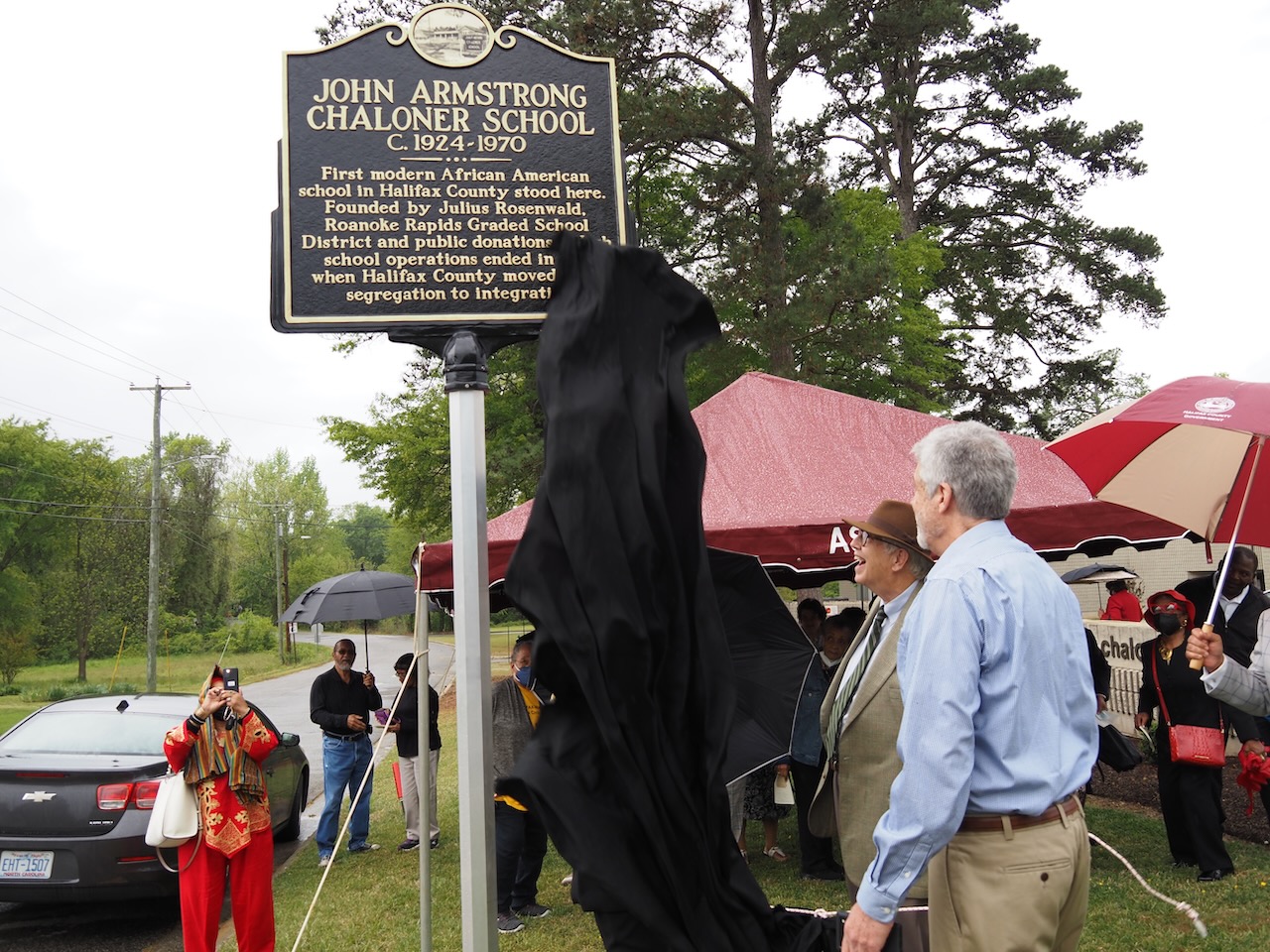With his descendants in attendance Friday, the efforts of John Armstrong Chaloner to pave a way to education for African-American students were recognized with the unveiling of a historical marker at the place of learning which still bears his name — Chaloner Middle School.
The program was a joint effort between the city’s school system and the John Armstrong Chaloner Marker Advisory Committee.
“We are so honored to have the great nephew of John Armstrong Chaloner with us today and his great-great nephew,” said Rex Stainback, a Roanoke Rapids City Council member and member of the advisory committee. “They came all the way from New York and we certainly appreciate this.”
Stainback said the biggest welcome of the day went to the friends and alumni of the school. “This historic marker has surely taken awhile but your day has arrived.”
In his invocation, Rev. Michael Simmons of First Baptist Church acknowledged the significance of the day and the Chaloner family. “We thank you for the Rosenwalds, we thank you for Booker T. Washington, uniting with him and starting schools throughout the land. We thank you for this school that you made possible.”
James Pierce, an alumni of the school who served as master of ceremonies, said, “The school history is a long and special one to me.”
Pierce said as he looked at the photos on display he was struck with memories of his time there. “I grew up in the elementary building. I met my bride of 54 years at this site so I got some pretty good blessings out of here.”
-
 Click to open image!
Click to open image!
Click to open image!
Click to open image!
-
 Click to open image!
Click to open image!
Click to open image!
Click to open image!
-
 Click to open image!
Click to open image!
Click to open image!
Click to open image!
-
 Click to open image!
Click to open image!
Click to open image!
Click to open image!
-
 Click to open image!
Click to open image!
Click to open image!
Click to open image!
-
 Click to open image!
Click to open image!
Click to open image!
Click to open image!
-
 Click to open image!
Click to open image!
Click to open image!
Click to open image!
-
 Click to open image!
Click to open image!
Click to open image!
Click to open image!
-
 Click to open image!
Click to open image!
Click to open image!
Click to open image!
-
 Click to open image!
Click to open image!
Click to open image!
Click to open image!
-
 Click to open image!
Click to open image!
Click to open image!
Click to open image!
-
 Click to open image!
Click to open image!
Click to open image!
Click to open image!
-
 Click to open image!
Click to open image!
Click to open image!
Click to open image!
-
 Click to open image!
Click to open image!
Click to open image!
Click to open image!
-
 Click to open image!
Click to open image!
Click to open image!
Click to open image!
-
 Click to open image!
Click to open image!
Click to open image!
Click to open image!
-
 Click to open image!
Click to open image!
Click to open image!
Click to open image!
-
 Click to open image!
Click to open image!
Click to open image!
Click to open image!
-
 Click to open image!
Click to open image!
Click to open image!
Click to open image!
-
 Click to open image!
Click to open image!
Click to open image!
Click to open image!
-
 Click to open image!
Click to open image!
Click to open image!
Click to open image!
-
 Click to open image!
Click to open image!
Click to open image!
Click to open image!
-
 Click to open image!
Click to open image!
Click to open image!
Click to open image!
-
 Click to open image!
Click to open image!
Click to open image!
Click to open image!
-
 Click to open image!
Click to open image!
Click to open image!
Click to open image!
-
 Click to open image!
Click to open image!
Click to open image!
Click to open image!
-
 Click to open image!
Click to open image!
Click to open image!
Click to open image!
-
 Click to open image!
Click to open image!
Click to open image!
Click to open image!
-
 Click to open image!
Click to open image!
Click to open image!
Click to open image!
-
 Click to open image!
Click to open image!
Click to open image!
Click to open image!
-
 Click to open image!
Click to open image!
Click to open image!
Click to open image!
-
 Click to open image!
Click to open image!
Click to open image!
Click to open image!
-
 Click to open image!
Click to open image!
Click to open image!
Click to open image!
-
 Click to open image!
Click to open image!
Click to open image!
Click to open image!
-
 Click to open image!
Click to open image!
Click to open image!
Click to open image!
-
 Click to open image!
Click to open image!
Click to open image!
Click to open image!
https://www.rrspin.com/news/7253-chaloner-s-legacy-honored-with-historic-marker.html#sigProIdac1a4d5a35
History
Florine Bell, a graduate of the school who helped lead the effort for the marker, gave an exhaustive history of the school from its start in 1924 as the first modern school in Halifax County for Black students and one of the many founded by Julius Rosenwald, the Roanoke Rapids Graded School District, and public donations.
The high school ceased operations in 1970 when Halifax County moved from segregation to integration.
“This place offers much excitement to the extent it feels surreal,” said Bell. “I am incredibly grateful and have been blessed by God to stand here on this momentous and historical day to commemorate and to celebrate the existence of the former John Armstrong Chaloner High School.”
Bell described the school as a second home for its students for 12 years.
Chaloner was one of the heirs of the Astor and Chanler estates.
He would travel south to help industrialize struggling areas such as the Roanoke Valley, Bell said. “He arrived in Roanoke Rapids about 1893 and invested in the Roanoke Navigation Company’s first power authority, introduced the first industrial cotton mill complex, orchestrated the town’s streets, organized the town’s first churches, built schools and houses for his workers and other citizens.”
Chaloner was a proponent of education, Bell told the audience. “He deeded 10 acres of land on the 23rd of January, 1923, to the board of trustees of Roanoke Rapids to build a modern public school for African-Americans. That land developed into the John Armstrong Chaloner High School building where we are today.”
The school became one of 45 Rosenwald Schools built in Halifax County and was one of the few to be made of brick rather than wood, she noted.
Across the south from 1910 to 1932 at least 700,000 Black children attended more than 5,000 Rosenwald Schools — envisioned by Washington and Rosenwald, the CEO of Sears, Roebuck.
“Only after learning of Chaloner school’s existence, I believe he came to know that the school he was responsible for — the land, the building had been accomplished. His dream had been fulfilled for us people of color.”
The school has left a lasting legacy, Bell said. “We shall long remember our trophy-winning basketball and football teams and our award marching band and majorettes. We have a great deal of history here today. This historical marker will serve as an informer and as a reminder of John Armstrong’s investments as a town founder and our cherished John Armstrong Chaloner High School. It is a school that has survived the test of time. Through the Great Depression we came. World War II — we came. The Korean War we’re still here. The Vietnam War we’re still here and the civil rights movement finally coming in — 1964 and here we are today.”
Superintendent’s remarks
Roanoke Rapids Graded School District Superintendent Julie Thompson said, “I want to thank all of you for coming to this historic event which wouldn’t have come to fruition without the tireless efforts of Dr. Florine Bell.”
It was Bell who spearheaded the marker idea, Thompson said. “One year ago our board of trustees passed a resolution … commemorating the school and the district and the Roanoke Rapids High School Alumni and Friends partnered to pay for the marker we unveil today.”
She said GW Hux and Company donated the funds to support the ceremony as well as Mandy and Josh Clark, Stainback and his wife Terri, Mike Askew and the Roanoke Rapids Public Works Department. Cindy Boone discovered the deed. “This process of many people partnering to do great things exemplifies our district’s vision of together we succeed and I think it envisions the vision of the John Armstrong Chaloner School as well.”
Thompson said the school was known for its innovative approach to education and meeting the individual needs of each student. “The school had a strong emphasis on discipline and personal responsibility. Many of the students who have attended this school have gone on to successful careers and lives. This legacy is powerful and it continues to live on through you as well as the students and staff who walk our hallways at Chaloner Middle School today.”
Family
John Winthrop Aldridge, Chaloner’s great nephew, said his great uncle came to the area 130 years ago.
Chaloner was a philanthropist who established a juried prize for American artists to allow them to study with artists in Europe. The Chaloner Art Prize is still annually awarded. “He helped to develop an industrial gizmo called the self printer and was determined to put it to profitable use in a new knitting factory powered by hydroelectricity and so he found his way here.”
In Roanoke Rapids Chaloner bought land, gave a name to the city, established the Roanoke Rapids Power Company and the United Industrial Company to operate the mill.
He asked his friend, an eminent architect named Stanford White to design all the buildings, which included employee houses.
While his business ultimately failed, others picked up the challenge, acquired the buildings and hydroelectric rights and Roanoke Rapids prospered, Aldridge said.
Moving to Virginia and changing his name to Chaloner from Chanler due to a falling out with siblings, “He became a benevolent, if eccentric figure in his home region, having built a very large swimming pool for public use which the public was invited to and two generations learned to swim. He converted a barn into a movie theater where for a decade folks saw their first movies for free.”
Chaloner welcomed both white and Black to the theater and pool as well as a landing strip he built for a local barnstormer to give plane rides to children.
Aldridge said the school and his other projects in Roanoke Rapids were always close to Chaloner’s heart. “His lifelong generosity left little thought for his own well-being. And at his death in 1935 he was like so many millions of Americans in the depth of the depression essentially destitute.”
He had no children of his own but numerous nieces and nephews. “But in a larger sense, perhaps, his true heirs are the students past and present who have been educated in this pioneering schoolhouse during the past hundred years.”
Aldridge closed his remarks by saying, “On behalf of the extended Chanler-Chaloner family, I thank you for keeping in memory Uncle Archie’s name and service to the community and we congratulate you on continuing your most important work — the education of the young now for a hundred years in this school.”
Aldridge presented Bell with Chaloner’s own Bible engraved with his name and the date of his confirmation in 1894. In turn, Bell presented Aldridge and his great-great nephew David S. Chanler with plaques.
Chanler told the audience that the name means blanket makers. He and wife visited Chaloner’s house in Virginia the day before the Roanoke Rapids ceremony and saw the pool, which looked more like a pond.
Chanler presented the school system a framed reproduction of a Baltimore Sun editorial about Chaloner.
Few and Mallory
Tyus Few, chair of the Halifax County Board of Education, said, “Deep in the archives of public education in Halifax County, there were many, many schools. Many are demolished and a lot of them are no longer in operation. But here in the northern part of Halifax County still lies an icon of public education — John Armstrong Chaloner.”
While many schools “have bitten the dust during a time of separate but equal, Chaloner still stands,” Few said. “It is my hope that on this day … that the citizens of Roanoke Rapids will cherish the marker as so endowed the hallowed grounds of this school.”
Before several resolutions were read, current Chaloner Middle School Principal Angela Mallory said she remembered her mother and uncle telling her stories about Chaloner High School. “It was just a pleasure and I look forward to hearing my mom and Uncle Snow talking about their time here at Chaloner. The alumni of John Armstrong Chaloner is second to none. From actively participating in community events to paving the way for advancement, the effect of the alumni can be felt all around us — specifically the commitment and dedication of Dr. Florine Bell and others to have this historical marker placed at our school commemorating the historical significance of John Armstrong Chaloner School — the first modern African-American school in Halifax County.”
Mallory said she is forever indebted to the notable alumni of the school “for paving the way and pouring into children that looked like me. With the placement of this marker, the rich legacy of John Armstrong Chaloner School will be forever remembered for years to come.”








